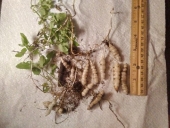Sunchoke Soy Sauce Pickles &
The Basic Soy Sauce Pickle Method
Translated from many Korean recipes for "pig potato" pickles (doeji gamja jangajji)
Note: Because harvest amounts vary, pickle making, unlike baking, is better suited to ratios rather than exact measurements. The following recipe is given in ratios than can and should be changed slightly to suit the tastes of the family.
Vegetables:
Sunchoke roots
Optional suggested flavoring vegetables:
Peeled garlic
Fresh hot peppers
Peeled and sliced ginger
Onion petals or quarters
Any other vegetable that can be eaten raw and will stand well in brine and you have on hand can be added
Brine- measured in roughly equal parts according to volume of raw vegetables
Plain water or anchovy seaweed broth
Soy Sauce (not low sodium)
Vinegar ( recommended fruit or rice vinegars)
Sugar or sweetener (start with half the measure and add more to taste)(brown or sugar like syrups could be substituted eg
honey, maple syrup, fruit syrups)
Seasonings such as black or chili peppers, bay leaves, dried
mushrooms etc can be added.
Note: do not attempt to reduce the soy sauce by too much, salt is important for preservation and salt reduced by too much will result in a pickle that spoils quickly. However; reduced salt pickles may be made for quick consumption and pickles meant for aging should have a higher ratio of soy sauce.
Method:
Thoroughly scrub and clean the sunchoke roots, trim unpleasant bits, and slice into bite sized pieces or thin rounds.
Prepare the other accompanying vegetables, wash clean trim slice, etc.
Place all prepared vegetables raw into clean or sterilized container/s and set aside. Containers may be sterilized by boiling water or steam.
Prepare the brine enough to cover the vegetables in their containers/s.
If making anchovy broth, boil dried anchovy and seaweed first, if not, begin with fresh water. If using dried seasonings simmer in water or broth first to release flavor. Add the remaining brine ingredients to the saucepan and bring to a boil. Remove from boil and taste the brine, add sweetener/water/soy sauce/vinegar until desired taste is reached. Brine should be salty and slightly sour and sweet and just a little bit strong. Pour hot brine over the prepared vegetables. Cap loosely and let cool to room temperature. Cap tight and place in fridge once cooled/next day. Wait 3 days for flavors to develop, the pickles will keep for several months stored in the fridge under the brine. Remove portions with clean utensils only and pickles will not spoil, but may lose texture if kept for too long. Never return uneaten portions to the main container.
Serve pickles in small portions alongside main dishes or dice and add into recipes. Do not discard the brine, it's delicious as a dipping sauce or marinade.
This is a basic pickle that most Korean families have at all times in their fridge as it is quick and simple to make. Often huge batches are made with a harvest of seasonal vegetables and shared among friends and family. They make great gifts, I still have a large container in my fridge from a neighbor who has since moved away. If the brine is plentiful and still good, fresh vegetables can be added into the brine (if someone has cherry picked a certain veg out of it more can be added) and the pickle can be fed this way for a while. The flavor deepens with age and the spiciness of the hot peppers and garlic mellow out. The sunchokes are not essential, try making the pickle with garlic scapes, garlic, onions, peppers, spring onions, cucumbers etc.

 4
4





 6
6














 1
1




 4
4














 1
1




 7
7




 6
6




 4
4






















 7
7




 3
3




 5
5




![Filename: story8_3_1.jpg
Description: [Thumbnail for story8_3_1.jpg]](/t/204599/a/218028/story8_3_1.jpg)
 6
6




 3
3




 1
1




 2
2




 3
3




 5
5




![Filename: hq720.jpg
Description: [Thumbnail for hq720.jpg]](/t/204599/a/218230/hq720.jpg)
![Filename: download-(1).jpeg
Description: [Thumbnail for download-(1).jpeg]](/t/204599/a/218231/download-(1).jpeg)
 1
1




 1
1




 2
2




 5
5




 3
3








